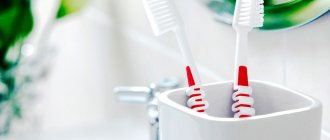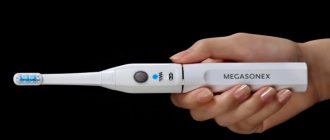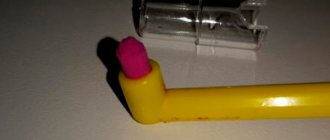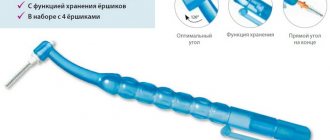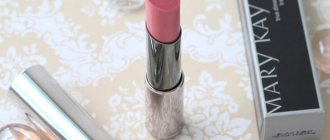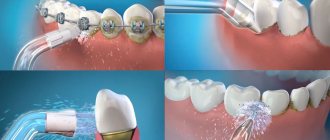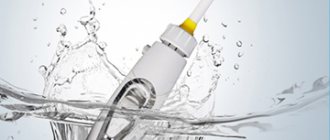Before answering this question that our clients ask us, let me turn to the history of the creation of these hygienic devices. This will help you find the answer even without expert advice.
No one can say for sure when the toothbrush first appeared. Even ancient people had a need to clean their teeth; for this they used bunches of grass and crushed plant branches. In Ancient Egypt, teeth were cleaned with ash. Several thousand years ago, Chinese nobles acquired special devices reminiscent of modern toothbrushes. Both the brushes themselves and the cleaning products improved over time, and in the 20th century, electric toothbrushes appeared, which, it seemed, would finally solve the problem of destroying plaque.
In 1955, the American dentist Gerard Moyer drew attention to the fact that his clients had dental problems (caries, periodontal disease) despite the fact that these people regularly brushed their teeth with the most modern means at that time and followed the recommendations of dentists. After carefully analyzing the nature of the diseases and identifying the foci of their occurrence, Moyer came to the conclusion that classical brushing of the oral cavity with a toothbrush cannot guarantee complete removal of plaque. Even after the most thorough cleaning, there were areas of the oral cavity on which persistent plaque formed, which became the cause of the disease. Therefore, additional exposure to these areas was required. Thus was born the idea of creating a device that could generate a water stream under pressure, which, penetrating into these hard-to-reach areas, washed away the remaining plaque. The device was created already in 1958, called an “oral irrigator” and was designed to complement the procedure of regular toothbrush cleaning with effective irrigation, providing the highest level of hygienic protection. So, the creators of the irrigator themselves answered the question “irrigator or brush”: “both irrigator and brush.”
Daily care of teeth and gums
It is known that the more carefully we take care of our teeth at home, the less money we will spend on dental services in the future. But for high-quality prevention of diseases of teeth and gums, it is not enough to use only an electric or ultrasonic toothbrush and toothpaste. The care should be complemented by stationary irrigators - modern high-tech devices that help, using water pressure, to care for the oral cavity and clean the interdental spaces.
Purpose of devices
An electric brush is an excellent replacement for a regular brush.
But a simple toothbrush cannot clean your teeth of plaque and food debris the way an electric device can. A person uses a regular toothbrush for 3-5 minutes, as recommended by dentists. Only during this period of time is it possible to manually clean all surfaces of the teeth so as to remove plaque containing many unsafe microorganisms. But an electric teeth cleaning device helps to significantly save effort and time, because vibrating bristles remove dirt much faster.
When using an electric toothbrush, the bristles in it make a back-and-forth motion, and they can also move up and down. This promotes more thorough and faster cleaning, thanks to the vibration created by the motor. So the procedure takes about two minutes.
The irrigator is a modern device that copes with several tasks at once: it cleans hard-to-reach areas of the oral cavity, massages the gums, and prevents the formation of stones. With the help of the device, in a short period of time, food residues are removed where a regular or electric brush cannot penetrate. The device delivers a thin stream of water or a medicinal solution under strong pressure, which helps wash away food residues after brushing the toothbrush, strengthening and improving blood circulation in the gums.
How to use the irrigator correctly is written here.
The device is equipped with a reservoir for liquid and nozzles. There are two types:
- Stationary. Differs in power.
- Portable. The main feature is compactness.
An irrigator is an excellent device for daily use, as well as for the treatment of periodontal disease and other diseases of the oral cavity when using special medicinal decoctions or solutions.
Why is just a toothbrush not enough?
After eating, a favorable nutrient environment for billions of bacteria is created in the human mouth. Some of these microorganisms, when constantly exposed to tooth enamel, cause bad breath and subsequently lead to caries. That is why it is better to clean the oral cavity of pathogenic bacteria as thoroughly as possible.
To more or less efficiently brush your teeth with a toothbrush, you need to brush them for at least 3 minutes, paying attention to each tooth. Most often we brush our teeth superficially, in a hurry. As a result, even the modest benefit that a toothbrush brings comes to naught.
In addition, the brush cannot clean the spaces between teeth. But this is where food debris gets stuck and bacteria multiply! Therefore, a toothbrush and irrigator complement each other perfectly. In particular, irrigators are more functional and do work that a toothbrush simply cannot do. This includes the hydromassage option, which increases blood flow in soft tissues and reduces the likelihood of developing infectious diseases.
In addition, irrigators are indispensable for caring for implants and braces. The operation of the device is adjustable, so they can be used to care for problem gums. When answering the question: “Which is better, an irrigator or a toothbrush?”, one should remember that irrigators are used not only for prevention, but also to treat the oral cavity. Toothbrushes perform a purely preventive function.
Minuses
The main disadvantages of the devices include:
- Relatively high cost - the average price for dental centers varies between 4-12 thousand rubles. depending on the configuration.
- They do not replace daily hygiene procedures , but act in addition.
- a power connection when using the irrigator , while portable models do not have sufficient power and require frequent recharging.
- There is no possibility of contactless charging.
- The nozzles do not rotate around their axis, but make vertical movements.
- Dental centers do not provide the ability to connect the irrigator to the water supply network.
- Not recommended for use by children as they do not have sufficient manual skills.
There are contraindications for the use of systems in active and acute diseases of periodontal and dentine: extensive or deep caries, periodontitis, periodontal disease, gingivitis, as well as bleeding and hyperesthesia of tooth enamel (sensitivity).
Important! In the first days of use, the user may experience discomfort, and redness and signs of bleeding may form on the gums, so it is recommended to start use with the lowest pressure or pulsation value, gradually increasing these values.
Is a toothbrush important?
Conventional, electric and ultrasonic toothbrushes are classified as primary oral hygiene products. They remove bacterial plaque from the enamel and clean out large pieces of food left after eating. However, such devices are not capable of efficiently cleaning the dental space. More recently, dentists recommended using dental floss for these purposes. Now the opinions of experts are divided: studies show that the use of floss is ineffective and dangerous.
Therefore, for secondary oral hygiene it is better to use irrigators. A directed jet of liquid efficiently cleans gum pockets and interdental spaces. In this case, injury to the gums is excluded.
Is a waterpik a substitute for a toothbrush? No, it doesn't replace it. However, brushes and irrigators complement each other perfectly and provide comprehensive oral care.
Features of the devices
Irrigators and electric toothbrushes have some distinctive features that can make it more convenient for a person to make a choice if it is difficult to decide what to buy for oral care.
Irrigator
In irrigators, the types of water flow affecting the teeth may differ from each other. They are formed in various ways. The flow can be pulsed, microbubble, or in the form of a continuous jet.
Innovative – pulsating and microbubble technologies, which make it possible to quickly and effectively clean enamel and remove contaminants from dental structures. A pulsating jet hits the surface of the teeth, instantly removing particles of dirt from hard-to-reach areas, eliminating plaque.
In a microbubble flow, liquid streams combine with air bubbles, forming hydraulic microshocks under high pressure. This results in effective cleaning and simultaneous massage of the oral cavity.
Irrigators can be supplied with various attachments that help make work much more comfortable. With the help of nozzles, they not only clean the oral cavity and orthopedic products, but also clean the tongue, spray special products, and rinse the nose.
An electric toothbrush
Using an electric device, you can effectively clean your teeth, gums, tongue and inner cheeks. The device is equipped with the following elements:
- Brush head. It is removable, so the presence of several such attachments allows several people to use the device.
- The basis. A part that acts as a nozzle holder.
- With a handle. It has a built-in motor and power source.
The device operates using batteries, a rechargeable battery that requires charging. Each device must come with a charger. There are also brushes that operate exclusively on mains power.
Among other things, most modern electric brushes are equipped with additional functions:
- Display. Manufacturers often equip the device with a liquid crystal display, through which the user can count the time while brushing their teeth.
- Ultrasound indicator. It signals that it is time to finish the process of cleaning the oral cavity.
- Timer. It is designed to sound a sound signal or stop the operation of the device. The average duration of work is 2-3 minutes.
- Modes. Some electric brushes have several operating modes: for cleaning the surface of the tongue, sensitive enamel, and whitening.
- Pressure sensor. If excessive pressure is applied to the device, the gums and enamel may be damaged. Some brushes are equipped with a sensor that acts as a safety device that prevents strong pressure.
Advantages and disadvantages of oral care products
Finding out which is better: an irrigator or an electric ultrasonic brush can only be done by comparison.
Irrigators have the following advantages:
- Prevents the development of periodontal disease, gingivitis, stomatitis and other oral diseases;
- Remove plaque without damaging the enamel;
- Work in several modes;
- The case is resistant to mechanical damage;
- Equipped with different attachments.
Among the shortcomings are the limited rotation of the nozzles and the lack of wireless charging.
The advantages of electric toothbrushes include:
- Nozzles for removing plaque from the tongue;
- Effective removal of dental plaque;
- Presence of a timer;
- Teeth whitening after tobacco and coffee.
The disadvantages of such devices include rough impact. In particular, electric brushes often damage gums and can even loosen teeth.
Can I use an irrigator if my gums bleed?
Bleeding gums are not a contraindication. Do not forget that with the help of an irrigator, we, on the contrary, massage them and clean the oral cavity even better. People with heart disease, rosacea, acute periodontitis, as well as those who have recently installed an implant or simply undergone some kind of surgical intervention in the oral cavity should refuse to use the device (or use it with caution).
Article on the topic
Smile wider! How to get rid of bleeding gums
Which irrigator model to choose?
Among the high-quality models that have earned the approval of dentists are:
- WaterPik WP-70 Classic is an irrigator with four replaceable nozzles and a pulse frequency of 1,200 vibrations per minute. The reservoir holds 1 liter of water and can be wall mounted.
- Oral-B Professional Care OxyJet + 3000 – the kit includes 10 replaceable heads and removes plaque using microbubbles. After 2 minutes of operation, the device gives a signal that it is time to complete the procedure.
How to choose?
When choosing a suitable dentist, you must be guided by the following criteria :
- Manufacturer's reputation and customer reviews : before buying a device, you need to read reviews on the Internet, compare the pros and cons, and also give preference to models that are recommended by experts and have a high rating among users.
- Pressure supply technology : preference should be given to microbubble and pulsating technology.
- Stationarity and portability : in addition to the obvious, the battery capacity, as well as the intensity of cleaning, will depend on these parameters. Stationary models have a higher pressure - from 600 to 800 kPa, and the capacity of mobile versions varies between 200-400 kPa.
- Number of nozzles : the kit includes from 2 to 10 nozzles. The higher their number, the more functions the device performs. The widest selection is provided for portable devices.
- Intended purpose : if the device is intended for recovery after professional procedures, treatment, and care of dental structures, then you should give preference to devices with an expanded configuration, including attachments for cleaning braces, dental bridges, washing tonsils and maxillary sinuses.
- Pulsation frequency : at least 900 microbeats per minute - the coefficient of impact on dental plaque will depend on this parameter. However, high power has an adverse effect on fillings, crowns and teeth that are prone to sensitivity. A power of 1200 mcd/min is considered optimal, so if you have orthodontic structures and sensitivity, a power of up to 3000 mcd/min will be sufficient.
- Tank capacity : from 200 to 1000 ml. The larger the tank, the less time the cleaning procedure will take.
Attention! Stationary platforms are suitable for home use for preventive purposes, and mobile devices are suitable for caring for orthodontic systems or therapy. If you have a limited budget, you should choose models from the middle price category (from 6 to 8 thousand).
Toothbrush and irrigator
A toothbrush (regular, electric or ultrasonic) and an irrigator are two things that will help you keep your teeth in perfect order! It is impossible to choose between them which is better, because... their functions are different. An irrigator does not replace a brush, and one is not enough - a comprehensive application is necessary.
After brushing your teeth with a toothbrush, use an oral irrigator. The operation of this device is based on pulsating water jet technology. A pulsating stream of water penetrates into the most inaccessible places in the oral cavity - interdental spaces and gum canals, eliminating bacteria from them. At the same time, a gentle massage of the gums occurs. Regular use of an oral irrigator can even relieve chronic bleeding gums! Bad breath also goes away. But you should not replace a toothbrush with an irrigator.
Dentists recommend using a toothbrush and irrigator in combination, and not instead. These are your teeth's best friends! You can see the types of Waterpik irrigators in our catalog.
Pros of devices
Dental centers have the following advantages :
- A professional approach to oral hygiene at home.
- Maximum and comprehensive cleansing of the oral cavity.
- Cleaning plaque in hard-to-reach places .
- Quick cleaning , taking from 30 seconds to 2 minutes daily, instead of 3-4 minutes. during manual cleansing.
- The versatility of the device allows you to cope with a wide range of tasks, be it massaging the gums, caring for orthodontic structures, or cleaning the surface of the tongue.
- Ease of use - some devices are equipped with timers and pressure sensors that allow you to adjust the time and depth of the device's impact on hard and soft tissues during the cleaning process.
- Effective prevention of dental pathologies , carious lesions, periodontal and dentin diseases.
- The ability to use professional attachments that provide an individual approach to the care of braces, veneers, mouth guards and other dental structures.
- Almost complete absence of contraindications and restrictions on use.
- Possibility of adjusting the mode and pressure of the jet.
By the way! In addition, the devices come with cases, instructions and stationary platforms to ensure proper use and storage.
What is the result: a sonic or an ultrasonic brush?
Sonic and ultrasonic brushes work differently and are suitable for different purposes.
An ultrasonic brush should not be used during acute inflammation due to infectious gum disease - heating the tissues and increasing blood circulation can be harmful, contributing to the spread of infection and deterioration of health. However, in case of chronic diseases, the benefits of using ultrasound, on the contrary, will be noticeable - it helps prevent exacerbations, strengthening and healing the gums. It is better to choose an ultrasonic brush in the following cases:
- after professional cleaning or bleaching;
- when staining enamel with medicines or food;
- for dental care without visible damage.
A sonic brush is best suited if:
- you have veneers, fillings, braces and other orthodontic structures installed;
- there is chronic inflammation of the gums;
- there is old plaque, tartar in the interdental space or on the back surface of the teeth.

